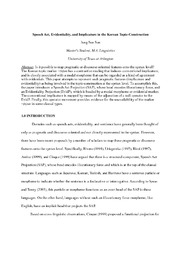
ATTENTION: The works hosted here are being migrated to a new repository that will consolidate resources, improve discoverability, and better show UTA's research impact on the global community. We will update authors as the migration progresses. Please see MavMatrix for more information.
Show simple item record
| dc.contributor.author | Son, Jung Sun | |
| dc.date.accessioned | 2010-11-17T00:57:40Z | |
| dc.date.available | 2010-11-17T00:57:40Z | |
| dc.date.issued | 2010-11-17 | |
| dc.identifier.uri | http://hdl.handle.net/10106/5191 | |
| dc.description.abstract | Is it possible to map pragmatic or discourse-oriented features onto the syntax level? The Korean topic marker -(n)un has a contrastive reading that induces conventional implicature, and is closely associated with a modal morpheme that can be regarded as a kind of agreement with evidentials. This paper attempts to represent such pragmatic features (implicature and evidentiality) as being involved in the topic-construction at the syntax level. To accomplish this, the paper introduces a Speech Act Projection (SAP), whose head encodes illocutionary force, and an Evidentiality Projection (EvidP), which is headed by a modal morpheme or evidential marker. The conventional implicature is mapped by means of the adjunction of a null operator to the EvidP. Finally, this operator movement provides evidence for the unavailability of the marker -(n)un in some clausal types. | en_US |
| dc.language.iso | en_US | en_US |
| dc.publisher | Linguistics & TESOL | en_US |
| dc.subject | Linguistics | en_US |
| dc.subject | Speech act theory | en_US |
| dc.subject | Discourse analysis | en_US |
| dc.subject | Pragmatics | en_US |
| dc.subject | Korean language | en_US |
| dc.subject | Topic constructions | en_US |
| dc.title | Speech Act, Evidentiality, and Implicature in the Korean Topic-Construction | en_US |
| dc.type | Working Paper | en_US |
Files in this item
- Name:
- Korean-21-47.pdf
- Size:
- 274.3Kb
- Format:
- PDF
This item appears in the following Collection(s)
Show simple item record


